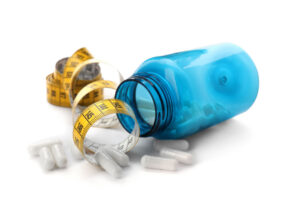Choosing a medication for attention deficit hyperactivity disorder can be confusing, especially when so many have similar active ingredients and effects on the brain. Stimulant medications like Vyvanse and Focalin are often prescribed to regulate symptoms of ADHD.
These medications increase the amount of norepinephrine and dopamine in the brain, which governs certain cognitive functions and reduces ADHD symptoms. Though Focalin and Vyvanse have similar effects on the brain and body, one may work better for you than the other.
In this article, we thoroughly compare these medications so you have the information you need to have a knowledgeable discussion with your healthcare provider.
If you are struggling with finding the right medication for ADHD, Klarity can help. In just 48 hours, you can connect with a healthcare provider for affordable online ADHD treatment. Your provider will develop a unique treatment plan, including prescription medication, to help you find relief from your ADHD symptoms. Schedule an appointment today to get started.
| Focalin | Vyvanse | |
|---|---|---|
| Drug Class | Schedule II stimulant | Schedule II stimulant |
| Brand / Generic Status | Brand name for dexmethylphenidate | Brand name (no generic) |
| Form(s) of the Drug | Immediate-release tablets; Extended-release capsules | Capsules and chewable tablets Capsules should not be crushed or chewed |
| Standard Dosage | 2.5 mg, 5 mg, and 10 mg immediate-release tablets; 5 mg to 35 mg extended-release capsules |
5 mg, 10 mg, 20 mg, 30 mg, 40 mg, 50 mg, 60 mg, and 70 mg capsules OR chewable tablets |
| Conditions Treated | FDA-approved uses: • ADHD |
FDA-approved uses: • ADHD • Binge-eating disorder Off-label uses: • Narcolepsy |
| Cost | Generic form (dexmethylphenidate): • $22 for 30, 2.5 mg tablets • $766 for 60, 35mg extended-release capsules |
Brand-name: • $400 to $450 for 30 days of 30mg capsules or chewable tablets |
| Side-Effects | Common side effects: • Trouble sleeping • Nausea • Stomach pain, headache • Nervousness • Loss of appetite • Weight loss • Dizziness Serious side effects: • Signs of blood flow problems in the fingers or toes • Unusual wounds Irregular heartbeat • Behavior changes • Uncontrolled muscle movements • Sudden verbal outbursts • Vision changes |
Common side-effects: • Anxiety • Diarrhea • Dizziness • Dry mouth Irritability • Nausea • Trouble sleeping • Vomiting • Weight loss • Upper stomach pain Serious side-effects: • Blurred vision • Irregular or fast heartbeat • Muscle twitching • Uncontrolled movements • Blood flow problems in the fingers and toes • Swelling in the ankles and feet • Rapid and unexplained weight loss • Mood changes, including aggression and depression |
| Warnings For Use | • May be habit-forming • Effectiveness decreases over time • Interactions with other drugs—consult a doctor before use |
Contraindicated for: • History of substance abuse • Heart abnormalities • Circulation issues • Mental health issues |
What is Vyvanse?
Vyvanse (active ingredient: lisdexamfetamine dimesylate) is a time-released stimulant used to treat ADHD symptoms by targeting neurotransmitters in the brain that control impulsivity, hyperactivity, and focus. It was approved for use by the FDA in 2007 and is considered a Schedule II controlled substance.
Forms and Dosages
Vyvanse is a prodrug, meaning it doesn’t activate in the body until the liver processes it. Because it also takes longer to process in the body, Vyvanse has a lower risk of abuse and addiction than ADHD medications like Adderall and Ritalin.
Vyvanse comes in 5 mg, 10 mg, 20 mg, 30 mg, 40 mg, 50 mg, 60 mg, and a max dosage of 70 mg capsules, and also comes in chewable tablets that follow the same dosage guidelines. This ADHD medication is taken first thing in the morning with or without food. Do not take Vyvanse anytime after 12 PM as it may interfere with your sleep pattern.
Conditions Treated
Vyvanse is FDA-approved to treat ADHD and some sleeping disorders like narcolepsy. It is also approved for use in those with binge eating disorder (BED). Vyvanse can also be prescribed off-label to treat certain conditions such as excessive daytime sleepiness, depression, and schizophrenia.
Off-label use means there’s scientific evidence that a drug is effective, but it’s not FDA-approved to treat that condition, which takes a lot of time and resources to receive.
Costs
Vyvanse is currently only in branded form and does not offer a generic version. This is one of the costlier ADHD medications on the market, with a one-month supply of 30 mg Vyvanse fetching between $400 and $450 outside of a health insurance plan. Contact your provider’s pharmacy department for more information on pricing under your current health insurance plan.
Side Effects
Most people taking Vyvanse do not experience side effects due to the more subtle nature of this medication’s delivery system. However, each person is different and side effects can occur when taking Vyvanse. Common side effects include but are not limited to:
- Anxiety
- Diarrhea
- Dizziness
- Dry mouth
- Irritability
- Nausea
- Trouble sleeping
- Vomiting
- Weight loss
- Upper stomach pain
Less common but more severe side effects of Vyvanse include:
- Blurred vision
- Irregular or fast heartbeat
- Muscle twitching
- Uncontrolled movements
- Blood flow problems in the fingers and toes
- Swelling in the ankles and feet
- Rapid and unexplained weight loss
- Mood changes, including aggression and depression
If you experience persistent or severe side effects, contact your healthcare provider immediately.
Warnings and Drug Interactions
Vyvanse is a potent Schedule II stimulant and a federally controlled substance which means it has a high risk for dependency. Misuse or abuse of this medication can lead to serious dependency issues, and individuals with a history of substance use problems should exercise extreme caution. It is vital to follow the prescribed dosage and seek regular medical supervision to minimize the risk of dependence and maintain the safe and effective use of Vyvanse.
Vyvanse may have adverse effects on individuals with certain health conditions. If you have had or are currently suffering from the following conditions, you should speak with your healthcare provider before taking Vyvanse:
- Heart abnormalities
- Circulation issues
- Mental health issues
- History of substance abuse
Licensed providers on Klarity provide personalized treatment. Find a provider that matches your needs and preferences.
What is Focalin?
Focalin (active ingredient: dexmethylphenidate HCL) is a central nervous system stimulant primarily used to treat ADHD in children, adolescents, and adults. This stimulant affects neurotransmitters in the brain that control hyperactivity, focus, and impulse control.
Forms and Dosages
When methylphenidate is produced, it’s possible to produce four different kinds of this chemical by rearranging the methylphenidate atoms. These arrangements are called isomers.
Of the four possible methylphenidate isomers, only one has any benefits in targeting ADHD symptoms, while the other four actually make ADHD worse. This single active, beneficial isomer was brought to market as Focalin IR (immediate-release) and Focalin XR (extended-release).
Research has shown that having the only active isomer in a medication like Focalin works better and with fewer side effects than other methylphenidate delivery systems like Ritalin.
Focalin capsules come in 5 mg, 10 mg, 15 mg, 20 mg, 25 mg, 30 mg, 35 mg, and 40 mg dosages. Focalin is the first ADHD medication that did not come with arbitrary dosage maximums from the FDA. It is considered twice as strong on a milligram vs. milligram basis as drugs like Ritalin and Concerta.
Conditions Treated
Focalin is FDA-approved for use in individuals with ADHD and narcolepsy. It can also be used off-label to treat fatigue in cancer patients, refractory depression in older populations, apathy for people with Alzheimer’s disease, and enhance memory.
Costs
Brand and generic forms of Focalin are currently available on the market. If you do not have health insurance, a one-month supply of Focalin costs approximately $250 for a 10 mg prescription.
Online manufacturer coupons may knock that price down substantially for your first month’s supply. For more information on accurate pricing under your health insurance plan, contact your provider’s pharmacy department.
Side Effects
While Focalin does have side effects, you may not experience them in the same way as someone else. It’s important to monitor any side effects you experience and reach out to your healthcare provider if they worsen or persist.
Side effects of Focalin include but are not limited to:
- Stomach ache
- Decreased appetite
- Headache
- Serious allergic reaction
- Nausea
- Sleep disturbances
- Anxiety
- Dry mouth
- Dizziness
- Seizures
- Blurred vision
- Priapism
Warnings and Drug Interactions
Focalin is also a Schedule II stimulant and a controlled substance that carries a substantial risk for dependency. The potential for abuse and addiction is a particularly significant concern for individuals with a history of substance abuse.
Open and honest communication with a healthcare provider is crucial before considering Focalin, as it can exacerbate existing conditions or trigger dependency. Strict adherence to prescribed dosages and close monitoring by a medical professional are essential to mitigate the risk of dependency and ensure the safe use of Focalin.
Focalin is a stimulant that can cause health complications for individuals with heart abnormalities, high blood pressure, and circulation issues. Contact your healthcare provider immediately if you experience palpitations, chest pain, or any other sign of heart problems.
Additionally, Focalin interacts with 181 drugs—of those most frequently checked, clonidine, Lexapro, Prozac, and Zoloft have moderate interactions. For more information on Focalin’s warnings and drug interactions, read your prescription’s accompanying literature and speak with an ADHD specialist who can explain the pros and cons of this medication.
Which is More Effective? Vyvanse or Focalin?
Vyvanse and Focalin are very similar in the way they target ADHD symptoms, but they can have drastically different effects on your specific type of ADHD. The best way to find a medication that works for you is to speak with a healthcare provider who knows your medical history and who can prescribe an effective ADHD medication.
See ADHD Providers Online Today at Klarity
You don’t have to find the right medication on your own. You deserve to experience relief from your ADHD symptoms and Klarity has the convenient online solution for you. Within 48 hours or less, we can place you with a licensed healthcare provider who can diagnose and treat your ADHD, if applicable.
Your mental health shouldn’t have to wait. Schedule an appointment to speak to a specialized healthcare provider about possible ADHD treatment.







